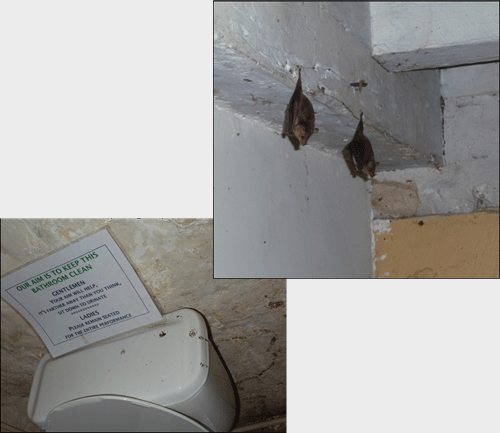FAQ (cont.): Why does a bat keep flying into my house at night?
Q1a: "So why doesn't it just stay in the tree and eat outside ?!?"
The bat has learned that inside your house, it's protected from rain, wind,
nocturnal predators (like tree-climbing cats), etc.
So, what we need to do is create a few nights of "nuisance" for the bat, all the while making sure that there are no other open windows in your house where it will re-settle.
Because bats' eyes are very sensitive to light, we can take advantage of their natural physiology and train them to stay outside.
When we've had this problem in our house, we found that a portable, battery-powered, motion-sensing light works better than keeping a light switched on.
The bats don't seem to habituate to the "flash" as they do to a continuous light source and it's easy to move a portable light around the house.
Just hang or position the light wherever the bat lands to rest.
It's likely that the bat will acoustically detect the "strange object" in its flight path just before the light actually flashes on, so it should learn fairly
quickly to stay away from this "strange & annoying object". PriceSmart used to sell these lights, but I'm not sure if they still carry them:
in any case, the light can be mains-powered: it's just more of a nuisance if you have to use an extension cable.
We also just shine an LED flashlight onto a bat hanging from a ceiling until it takes flight. Typically it will re-settle in the room, in the same original spot...so we blink the flashlight again, until it flies away.
We might have to do this 5-6 times and probably repeat this "light nuisance" for a second night. But it really doesn't take long for the bat to learn that the "safe resting spot"
is no longer trouble-free. (FYI - this is also why visiting a cave with roosting bats can be extremely harmful to the bats. Repeated disturbance with lights will cause them to
abandon the cave -- or more likely, they'll die because they can't find another unoccupied home.)
 Another low-tech solution I've read about, but haven't actually tried, is to hang thin strips of aluminum foil from the top of your window frame to the bottom sill.
I'd suggest cutting them about 1" (2.5 cm) wide and spacing them 1-2" (3-5 cm) apart. The bat will definitely detect the strips with its acoustics and the strips will
flutter as the bat approaches, making it more likely that the bat won't want to fly through the space between the strips.
Again, you'll need to make sure there are no
other open windows in your house while you're doing this "negative / aversion behavioural training" of the bat.
We don't want it to just shift to another new, safe spot in the house.
Another low-tech solution I've read about, but haven't actually tried, is to hang thin strips of aluminum foil from the top of your window frame to the bottom sill.
I'd suggest cutting them about 1" (2.5 cm) wide and spacing them 1-2" (3-5 cm) apart. The bat will definitely detect the strips with its acoustics and the strips will
flutter as the bat approaches, making it more likely that the bat won't want to fly through the space between the strips.
Again, you'll need to make sure there are no
other open windows in your house while you're doing this "negative / aversion behavioural training" of the bat.
We don't want it to just shift to another new, safe spot in the house.
 Another low-tech solution I've read about, but haven't actually tried, is to hang thin strips of aluminum foil from the top of your window frame to the bottom sill.
I'd suggest cutting them about 1" (2.5 cm) wide and spacing them 1-2" (3-5 cm) apart. The bat will definitely detect the strips with its acoustics and the strips will
flutter as the bat approaches, making it more likely that the bat won't want to fly through the space between the strips.
Again, you'll need to make sure there are no
other open windows in your house while you're doing this "negative / aversion behavioural training" of the bat.
We don't want it to just shift to another new, safe spot in the house.
Another low-tech solution I've read about, but haven't actually tried, is to hang thin strips of aluminum foil from the top of your window frame to the bottom sill.
I'd suggest cutting them about 1" (2.5 cm) wide and spacing them 1-2" (3-5 cm) apart. The bat will definitely detect the strips with its acoustics and the strips will
flutter as the bat approaches, making it more likely that the bat won't want to fly through the space between the strips.
Again, you'll need to make sure there are no
other open windows in your house while you're doing this "negative / aversion behavioural training" of the bat.
We don't want it to just shift to another new, safe spot in the house.